Nikon D90
-
-
Written by Gordon Laing
Nikon D90 design and controls
The Nikon D90 shares essentially the same external design as its predecessor, bar a handful of minor tweaks – this is of course no bad thing as the D80 already featured excellent build and ergonomics, so as the saying goes, if it ain’t broke, don’t fix it. So the external dimensions remain the same: 132x103x77mm, although the body only weight of 620g is slightly heavier than the 585g of its predecessor. We’ve pictured it alongside the Canon EOS 450D / Rebel XSi below which is slightly smaller at 129x98x62mm, although the Canon is noticeably lighter at 475g for the body alone.
 | ||||||||||||
The D90 is aimed at a higher-end market than the 450D / XSi though, with its closest Canon rival, in terms of price anyway, being the EOS 40D. This time, the Nikon’s smaller and lighter, with the EOS 40D measuring 146x108x74mm and weighing-in comfortably heavier at 740g without battery.
In terms of build quality and ergonomics, the D90, like its predecessor feels a step-up from models like the Canon below it – so while both it and the 450D / XSi share similar construction and materials, the D90 feels more solid and confident in your hands. While undoubtedly down to personal preference, we’d also say it’s more comfortable too with a larger grip complemented by Nikon’s trademark hooked inner area for your fingertips providing greater security.
Viewing both cameras from above equipped with their standard kit lenses does however reveal the D90 to be a much larger overall package. Sure, the Nikkor kit lens has almost double the range of the Canon and superior build, but if you’re weight-conscious and want a smaller DSLR kit, then the standard D90 package may be too large for you.
 |
It’s not surprising to find superior build quality and a better lens with the D90 kit as it costs comfortably more than the EOS 450D / XSi. Compare the D90 against the EOS 40D (which has roughly the same body price), and the higher-end Canon boasts tougher build quality with some assurances of weatherproofing. That said, the 40D is also much heavier and personally speaking, we still preferred the grip on the D90. As always we’d strongly recommend you pick the bodies up for yourself to see which looks, feels – and even sounds – best to you.
In terms of controls, the D90 is virtually identical to the earlier D80, and as such is ergonomically very well thought-out. Unlike cheaper models, the D90 is equipped with both a finger and thumb dial, and most of the adjustments are made by pressing and holding a button while turning one of the dials.
 |
On the top right surface, like the D80, are buttons to adjust the metering mode, exposure compensation, drive mode and AF mode, although these are all now circular in shape; simply press and hold the desired button while turning the thumb dial to make the adjustment. Above these to the front of the grip is the shutter release button surrounded by a rotary power switch; again as before when this is twisted clockwise, the upper information screen is backlit. It’s now also possible to configure this to fire-up the info screen on the back.
The upper screen continues the D90’s semi-pro aspirations and as before packs in a wealth of information including a five-segment battery indicator, the shutter and aperture, drive, flash and metering modes, icons for white balance bracketing, exposure and flash compensation (but no graphical scales for these), image quality, AF-point selection, AF mode, white balance and shots remaining. Sadly there’s no room for the ISO value to be shown unless you’re adjusting it, although a custom function allows you to swap the shots remaining with the current sensitivity if preferred. One consolation is both the ISO and shots remaining are shown at all times on the Info display at the back.
If you have more than 999 shots remaining, the D90 – like other Nikon DSLRs – abbreviates the figure with a K to represent thousands, so 2.3k would mean 2300 shots remaining. Maintaining a classy tradition from its film SLR days, the shots remaining also remains displayed on the upper screen even when the power to the camera is switched off.
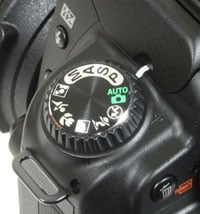 |
The main mode dial is on the upper left side of the body and features the same number of positions as the D80, although one of the scene presets has been swapped. So you’ll have access to the traditional PASM and Auto, along with Flash Off, Portrait, Landscape, Macro, Sports and Night Portrait scene presets; the D80’s Night Landscape has been swapped for a Flash Off mode here. See the Features page for full exposure details.
To the left side of body alongside the lens mount are buttons to popup the flash and activate exposure bracketing. Below these are the lens release button and a switch for auto or manual focus.
 |
Turning to the rear of the camera you’ll find five buttons running down the left side of the screen. Three are dedicated to the White Balance, ISO and Image Quality, with the first and last of these exploiting both control dials. With the WB button pressed, the thumb dial will set the white balance mode, while the finger dial makes any fine adjustments. With the QUAL button pressed, the thumb dial adjusts the compression, while the finger dial adjusts the resolution.
The WB button also doubles up as a Question control which delivers useful context-sensitive help at any time – very handy and well-implemented whether you’re a beginner checking out the basics or an expert delving into advanced menus.
To the right of the screen you’ll find a four-way rocker with a separate OK button in the middle and a lock switch below it; as with other Nikon DSLRs, this rocker can be used to adjust the active focusing point, so the lock prevents any surprises.
Above and below this control are the two main control differences between the D90 and its predecessor. Starting above the rocker, you’ll find a button labelled Lv that’s dedicated to firing-up Live View on the D90. This is much more sensible than having to turn the Release dial to select Live View on models like the D300 and D700.
Below the rocker is the dedicated Info button, first seen in this position on the D700; pressing this displays a vast degree of shooting information on the main screen which we’ll detail lower down this page.
Finally on the front of the camera on the right side (just where your right middle finger would rest) is a programmable Function button. This can be configured to switch the viewfinder grid on or off, adjust the AF Area mode, switch the central focusing point between wide and normal, lock the flash value (the default option), switch the flash on, instantly enable Matrix, Centre-weighted or Spot metering, jump to the top option in My Menu, or switch the camera from JPEG only to RAW plus JPEG mode.
Nikon D90 flash
 |
The Nikon D90 is equipped with a popup flash in addition to a hotshoe, although like the D80 before it, there’s no PC Sync port for external lighting – for that you’ll need to go to a semi-pro model like the Nikon D300 or Canon’s EOS 40D.
The D90’s popup flash has a Guide number of 18 / 59 (meters / feet) at the camera’s base sensitivity of 200 ISO and the fastest flash sync speed is 1/200. The D90 supports i-TTL balanced fill-in flash with its 420-segment RGB sensor when used with either the built-in flash, or the SB-400, SB-600, SB-800 or SB-900 units.
Press and hold the flash popup button on the side of the viewfinder head while turning the thumb wheel and you can adjust the flash mode between red-eye, off, Auto, slow-sync and rear-curtain sync; these options simplify in certain exposure modes. Press and hold the button while turning the finger dial and you can adjust the flash compensation from -3 to +1 EV in 0.3 or 0.5 EV increments. Flash bracketing is also available with two or three frames at 0.3, 0.5, 0.7, 1 or 2EV increments.
 |
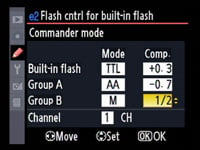 |
Custom setting e2 allows you to further configure the built-in flash for TTL use (the default), Manual (where you can choose the output level between full and 1/128), Repeating Flash (which strobes up to 35 times at a chosen frequency, depending on the flash power) and finally, Commander Mode (which uses the built-in flash as a Master for controlling one or more flashes in up to two groups).
The D90 supports Nikon’s Creative Lighting System (CLS) with the built-in flash, SU-800, SB-800 or SB-900 as Commanders and SB-R200, SB-600, SB-800 or SB-900 as remote units.
Nikon D90 viewfinder
| ||||||||||
Like its predecessor, the Nikon D90 features a penta-prism viewfinder with a large and bright view – these are a step-up from the penta-mirror viewfinders found in entry-level DSLRs. Nikon supplies a clip-on eyepiece cap to prevent stray light from entering the viewfinder, although you’ll first need to remove the eyepiece cup.
 |
The specification is essentially the same as the D80 before it: 96% coverage (95% on the D80) and 0.94x magnification; this is also similar to the 95% / 0.95x of the Canon EOS 40D’s penta-prism viewfinder. The percentage coverage of these models is roughly similar to budget models, but the magnification much larger – for example the Canon EOS 450D / XSi has a magnification of 0.87x, while the Sony Alpha DSLR A200 and A300 / A350 have viewfinder magnifications of 0.83x and 0.74x respectively. The bigger viewfinder magnifications (on DSLRs with the same format) literally translates into a view that looks larger. Like bigger screens, this doesn’t make affect image quality or coverage, but does make the composing process more comfortable and the focusing easier to check. If you look through the D90, then the 450D / XSi with both cameras sharing the exact same composition, the Nikon’s viewfinder looks noticeably bigger.
The viewfinders of Nikon’s mid-range DSLRs and upwards also sport a unique and very useful facility: an LCD alignment grid which you can simply switch on and off as required. This is a big advantage to the Nikon system as rivals such as Canon force their owners to buy and physically swap internal focusing screens – a fiddly process and one that’s also only offered on higher-end models.
In terms of shooting information, the D90’s viewfinder details are essentially the same as the D80. So you’ll see the shutter speed, aperture, an exposure compensation scale, shots remaining and icons for various modes; depending on the operation at that moment, the shots remaining indicator can alternatively display the continuous shooting buffer, White Balance, exposure or flash compensation values, capture mode or ISO sensitivity.
 |
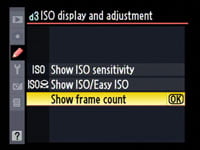 |
Custom option d3 allows you to configure the D90 to show the ISO value by default instead of the shots remaining, but it’s a shame you can’t view both at all times through the viewfinder – it’s worth noting the cheaper Canon 450D / XSi and even the budget EOS 1000D / XS now display both values at all times.
The 11 AF-points are indicated by round-cornered rectangles in the same diamond arrangement as the earlier D80. These, along with the alignment grid, are displayed using LCD markings which allow them to essentially disappear from view when not active.
So the D90’s viewfinder experience is essentially unchanged from its predecessor, but (lack of ISO value aside) that’s no bad thing as the D80’s remains very respectable today.
Nikon D90 Screen and Live View
The D90’s viewfinder may be unchanged from the D80, but Nikon’s significantly upgraded the screen to the same 3in VGA type you’ll find on the higher-end D300, D700 and D3 models. This ‘920k’ screen boasts 640×480 full colour pixels unlike the 320×240 pixel resolution its predecessor’s 2.5in ‘230k’ screen. While Canon has now started using similar VGA monitors on its latest EOS 50D and EOS 5D Mark II DSLRs, the older EOS 40D and EOS 450D / XSi use 3in 230k screens which may be the same size as the D90’s, but aren’t anywhere near as detailed.
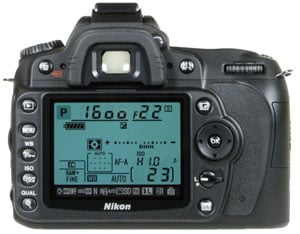 |
In use the D90’s screen looks very detailed, especially when playing images or navigating menus. Like most fixed monitors though, it can become hard to see in direct sunlight or at higher angles, which can limit its usefulness during Live View.
Like most Nikon DSLRs, the D90’s monitor is protected by a clip-on transparent plastic shield: the BM-10 shield is supplied with the D90. The screen looks better without, but the cover doesn’t greatly compromise the quality if you’d prefer to have the protection.
In another upgrade over its predecessor, Nikon has equipped the D90 with Live View, although the implementation is slightly different to existing Nikon DSLRs. First, the D90 sensibly features a new button on the back of the camera dedicated to starting Live View, unlike the D300 and D700 which force you to turn their release dial to Lv before then pressing the shutter release. This subsequently allows you to adjust the D90’s release mode separately, letting you choose the Self Timer or Continuous modes in Live View without having to go into a menu.
Secondly, while models like the D300 and D700 offered the choice of autofocus using either the traditional phase-change or contrast-based systems, the D90 is now contrast-based only. So while the mirror does have to flip and the shutter open to start Live View on the D90, they won’t ever drop back down again to take an AF reading. Unlike some older models, the AF is also simply activated by half-pressing the shutter release. We’ll fully describe how the AF performs during Live View in just a moment.
Third, the D90’s Live View now refreshes at a much smoother 24fps compared to the somewhat jerky 15fps of the D300 and D700; note Canon’s Live View on existing models refreshes at 30fps.
 |
 |
 |
With Live View activated by pressing the Lv button, the D90’s screen shows 100% coverage and exploits the full VGA resolution of the monitor for a highly detailed view. Basic shooting information including both the ISO value and shots remaining are shown running horizontally under the image, while a number of superimposed icons above this and along the top indicate aspects like the AF mode and image quality.
Pressing the Info button cycles between display modes in the same way as the D700: first a view with the full shooting information including superimposed items, second a cleaner view with just the basic shooting information at the bottom, and third, the same information again but now with an alignment grid. Like the D700 before it, this is a much more sensible implementation than the D300 which forced you to enter a custom menu to enable the grid.
Pressing the magnifying glass button allows you to zoom-in by up to 6.7x, which mathematically corresponds to a 1:1 view of the D90’s pixels on its VGA screen. The area shown on the screen at maximum magnification certainly represents a 1:1 crop, but unfortunately the live image itself is relatively coarse at this point and not that useful for critical focus confirmation. Revealingly if you then take the photo and zoom-in during playback to the same degree, the image is pin-sharp. Interestingly, the D90 offers two additional zoom steps in playback, but since these magnify beyond 1:1, the image appears increasingly fuzzy.
 |
 |
In contrast, Canon’s DSLRs with Live View are capable of delivering sharp details right up to their maximum live magnification. This becomes particularly apparent if you put the D90 alongside the 450D / XSi (which both share the same sensor resolution), frame identical compositions in Live View and zoom both into their maximum live magnification. Since the Canon 450D / XSi has quarter the screen resolution of the D90, a live image shown at (or close to) 1:1 will appear more magnified, but independent of this, the details remain sharper on the Canon and preferable for critical focus checking.
To be fair, the D90’s magnification during Live View is still useful, and does allow you to better confirm focus, but it doesn’t match the sharpness you’ll see when replaying images, nor that of the Canon models during maximum live magnification.
Another aspect where the D90’s Live View falls behind is the absence of a Live Histogram. Inexplicably, Nikon continues to exclusively reserve this feature for its flagship D3, which seems a little odd when it’s a standard feature even on the cheapest Canon DSLR. D90 owners may take some consolation it’s not on the D300 or D700 either. Note, the D700 and D3’s Virtual Horizon option is also unavailable here.
As described above, autofocus with the D90 in Live View uses a contrast-based system only. There’s a choice of three AF modes in Live View. Head over to custom mode a7 to choose between Face Priority, Wide Area (the default option) and Normal Area.
Wide and Normal Area will autofocus on a framed area which you can move around the screen using the multi-selector; the Normal Area mode unsurprisingly uses a smaller frame and is better suited to tripod-based work. Face Priority can track up to five faces and focus on the closest; like compact cameras, frames are shown around the active faces.
 |
 |
Contrast-based AF modes on DSLRs may avoid the mirror-flip and its subsequent noise and interruption to the image, but to date they’ve been much slower than relying on the traditional phase-change system. So on most current models you’d get the choice in Live View, but with the D90 Nikon’s made a brave decision to go contrast-based only, and justifies it by claiming improved performance.
In our tests with the D90’s contrast-based AF system in Live View, it could certainly lock onto some subjects in as little as just under two seconds. This is noticeably quicker than most rival contrast-based systems including those on the D300 and D700, but remains much slower than the sub-second AF performance using the optical viewfinder and phase-change system. It should also be noted the D90’s contrast-based AF could at other times take three or even four seconds to lock onto certain subjects, when again the traditional system snapped into place without complaint.
Face Priority was similar in practice. While the yellow square quickly appeared over subjects, we often had to press and hold the shutter release for several seconds before it turned green to confirm focus.
So while we admire Nikon for simplifying the Live View process with one system and a half-press of the shutter release, we’re not sure the D90’s contrast-based AF system is sufficiently quick to exclusively take the limelight just yet. Had this been an entry-level model, the simplification could have been justified to avoid confusion, but surely the D90’s more sophisticated target market could cope with the option of a quicker – if less slick – phase-change alternative like the D300 and D700.
Nikon D90 Menus
The Nikon D90 may feature a detailed upper LCD screen, but press the Info button at any time and the camera will present a wealth of shooting information on the main colour monitor. The D90 also recognises when conditions are getting darker and switches its daytime colour scheme of black characters on a light blue background to white characters on a darker slate-coloured background. It all works very well and looks great on the VGA monitor, although unlike the D60 (or Sony’s DSLRs), this information does not rotate when you’re framing portrait aspect shots.
 |
 |
The information is updated in real-time and includes the shooting mode, aperture, shutter speed, release mode, exposure compensation scale, flash, metering and AF modes, White Balance, quality, sensitivity and shots remaining; impressively there’s also separate indicators for each battery pack if you’re using the optional MB-D80 grip, although like the upper screen these remain five segment bars rather than a percentage remaining.
 |
A strip running along the bottom of the Info screen is devoted to the D90’s Quick Settings options, which as their name suggests, give you quick access to various popular settings without having to enter the main menu system. From left to right you can view and change the settings for the Long Exposure NR, High ISO NR, Active D-Lighting and Picture Control, along with assigning the Function or AE / AF-lock buttons.
By pressing the Info button once more, this lower strip takes priority with one of the details above highlighted in yellow. You can then use the four-way multi-selector to move the highlighter over the desired setting before then pressing the OK button to bring-up the relevant options. In practice this works in a similar way to the on-screen adjustments of Olympus DSLRs, and allows you to quickly and easily adjust a lot of settings without having to delve into menus to find the relevant page. Nikon first implemented this system on the D700 and it’s good to find it here on the D90.
 |
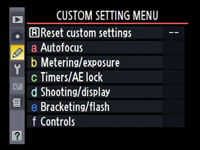 |
 |
Pressing the Menu button fires-up Nikon’s familiar user-interface, again looking great thanks to the high resolution screen. The main sections are indicated by tabs running down the left side, for Playback, Shooting, Custom Settings, Setup, Retouch and the new Recent Settings (which can be switched to the customisable My Menu if preferred). As always, pressing Question mark button at any time will popup helpful advice.
 |
 |
Customisation is a big aspect of the D90 with seven settings for AF, four for metering / exposure, five for timers / AE lock, 12 for shooting and display, six for bracketing / flash, and seven for controls. That’s 41 in all, which while fewer than the 50 on the D700, still gives you plenty of opportunity to tweak the camera. We’ll discuss some of the custom options throughout this review.
In playback the VGA screen really comes into its own with images looking highly detailed compared to average 230k monitors; even the thumbnail views look detailed. Depending on the display selected in the Playback menu, you can cycle through a great deal of information when replaying images.
 |
 |
 |
With every option selected, pressing the multi-selector up and down cycles between a full view showing with basic shooting information, a thumbnail with a brightness histogram and greater shooting info, three pages of detailed shooting information, a full view with flashing highlights, and finally a thumbnail with RGB and brightness histograms. If the optional GPS unit was enabled when the shot was taken, an additional page with location and time details is added.
 |
 |
There’s eight steps when zooming-in on images, although the sixth appears to be displaying it at 1:1 on the VGA screen, with the seventh and eight zooming beyond and therefore becoming progressively fuzzy. Zooming-out displays a series of thumbnails, first four, then nine, followed by 72 tiny images and finally a calendar view. The D90 also uses face detection during playback to frame subjects when zooming-in – this allows you to quickly check facial details without having to scroll to them first. Again the VGA resolution works a treat with these smaller details.
The Retouch menu allows you to perform a number of in-camera adjustments including D-Lighting, Red-eye correction, cropping, filter effects, colour balance, a resolution shrink, superimposing of multiple images, RAW processing, fine rotation, geometric correction and a new fisheye effect.
Nikon D90 Battery and connectivity
 |
The Nikon D90 is powered by the same EN-EL3e 1500mAh Lithium Ion battery pack as its predecessor, along with the D300 and D700 models. Nikon quotes 850 shots under CIPA conditions but that’s without Live View or movie recording – using either can eat through your batteries considerably quicker, so we’d highly recommend always carrying a spare.
Again like its predecessor and the D300 and D700, the D90 can take an accurate reading of the remaining battery life and display it as a percentage. Unlike Sony which proudly displays its percentage figures on-screen though, Nikon continues to inexplicably hide theirs away in a Setup menu. Accurate battery life indicators are a great feature, and it’s a shame Nikon doesn’t include the percentage value on the monitor in Info mode.
 |
By sharing essentially the same exterior design as its predecessor, the D90 can also use the same MB-D80 battery grip. This can take either two EN-EL3e’s or six AAs, while providing portrait grip and controls.
A rubber flap on the left side of the body opens to reveal an AV output (note the addition of audio now for movies), a mini HDMI port for connection to an HDTV, a DC input, USB port and an accessory terminal. The accessory terminal and HDMI port (not to mention audio output) are new over the older D80, but there’s still no PC Sync port for external lighting – for that you’ll need to step-up to the D300 or go for an alternative brand like the Canon EOS 40D.
The D90’s accessory terminal can be used to connect the optional MC-DC2 remote cord or GP-1 GPS unit, which mounts on top of the D90’s hotshoe and allows the camera to embed location and time details into the EXIF header of images.
The HDMI port can be configured to output signals in 480p, 576p, 720p or 1080i, and like the AV output, can be used for both slideshows and Live View output, but now in high definition; this is a real treat in use.
Finally, in terms of memory, the D90 unsurprisingly takes SD cards like its predecessor. Cards larger than 2GB must be SDHC compliant and at the time of writing, Nikon had certified models by Toshiba and Panasonic up to 32GB in capacity. There’s no official Wifi accessory, but Nikon does officially support a number of third party Eye-Fi models on the D90 including the Eye-Fi Card, Eye-Fi Home, Eye-Fi Share and Eye-Fi Explore. If one of these cards is inserted in the D90 and the Eye-Fi Upload option is Enabled, you can transfer JPEGs to a pre-selected destination – signal strength permitting.







